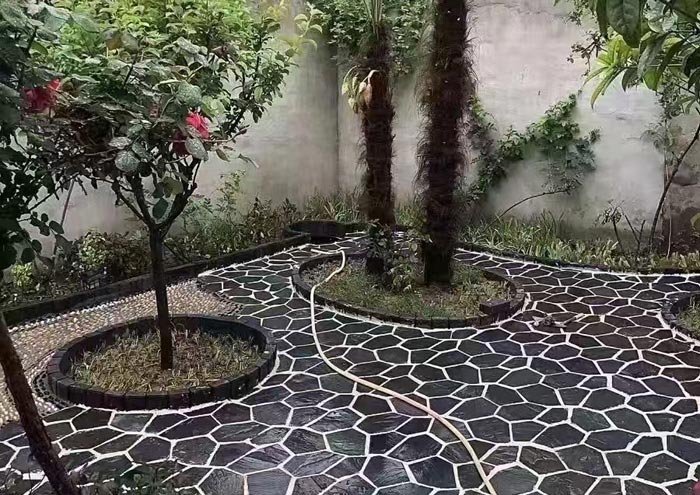Why Choose a Flagstone Patio?
When it comes to enhancing your outdoor space, a few options offer the timeless appeal and durability of a flagstone patio. Flagstone patios are not only visually striking with their natural stone textures and earthy colors, but they also stand the test of time, making them a popular choice for homeowners who want both beauty and functionality in their yards.
Overview of Flagstone Patios: A Timeless and Durable Outdoor Option
Flagstone is a sedimentary rock that is typically split into layers, giving it a naturally flat shape, ideal for creating pathways and patios. The unique characteristics of each stone, including its texture, color, and thickness, create a one-of-a-kind look that can’t be replicated with synthetic materials. Whether you’re aiming for a rustic, natural look or a more refined, elegant design, a flagstone patio can be tailored to suit your specific style and needs.
Benefits of Flagstone:
- Durability: Flagstone is known for its long-lasting nature. It can withstand harsh weather conditions, from scorching summers to freezing winters, without cracking or fading.
- Natural Beauty: The earthy tones and organic shapes of flagstone add a natural charm to any outdoor space, blending seamlessly with gardens, lawns, and other landscaping elements.
- Versatility: Flagstone can be used in a variety of designs, from simple, laid-back arrangements to more intricate, geometric patterns. It can also be combined with other materials like gravel, pebbles, or pavers to create a unique look.
- Low Maintenance: Unlike wood or concrete, flagstone requires minimal upkeep. It doesn’t rot, warp, or suffer from insect damage, making it a practical choice for busy homeowners.
Flagstone vs. Other Patio Materials: Making the Right Choice
When considering patio materials, you may also come across options like concrete, brick, or pavers. Each of these materials has its advantages, but flagstone stands out for several reasons:
| Material | Advantages | Disadvantages |
|---|---|---|
| Flagstone | Natural beauty, durability, slip-resistant, low maintenance | Higher initial cost, requires more installation time |
| Concrete | Affordable, versatile, quick installation | Can crack over time, requires regular sealing, less natural appearance |
| Brick | Classic look, durable, easy to repair | Prone to moss and mildew, limited color options |
| Pavers | Wide variety of colors and shapes, easy to install | Can shift over time, requires regular maintenance |
While flagstone may have a higher initial cost compared to materials like concrete or pavers, its long-term benefits, particularly in terms of durability and aesthetic appeal, often make it a more cost-effective option in the long run.
What You Need to Know Before Starting: Time, Budget, and Tools
Installing a flagstone patio is a rewarding project, but it requires careful planning and preparation. Before you dive into the installation process, it’s important to have a clear understanding of the time, budget, and tools required.
Time: Depending on the size and complexity of your patio design, installation can take anywhere from a few days to a couple of weeks. It’s important to set realistic expectations and plan accordingly, especially if you’re working within a specific timeframe or need the project completed by a certain date.
Budget: The cost of installing a flagstone patio can vary widely based on factors like the size of the patio, the type of flagstone used, and whether you’re doing the work yourself or hiring a professional. On average, you can expect to spend between $15 to $30 per square foot for materials and labor. However, this can be reduced if you choose to tackle the project on your own.
Tools: Here’s a list of essential tools you’ll need for the installation:
- Shovel and pickaxe for excavation
- Tape measure and marking paint for layout
- Wheelbarrow for transporting materials
- Rubber mallet for setting stones
- Level for ensuring even surfaces
- Tamping tool for compacting the base
- Masonry saw for cutting stones (if needed)
- Safety gear (gloves, goggles, knee pads)
Before starting the installation, make sure you have all the necessary tools on hand to avoid delays during the project. Additionally, consider renting specialized equipment like a masonry saw if you don’t already own one, as these tools can be expensive to purchase outright.
-
 Wholesale Loose Random Stone Wall Cladding
Wholesale Loose Random Stone Wall Cladding -
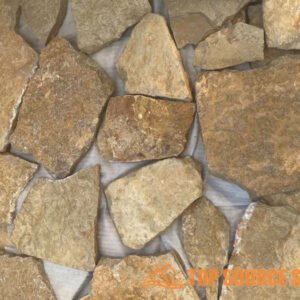 Wholesale Natural Random Loose Stone Cladding
Wholesale Natural Random Loose Stone Cladding -
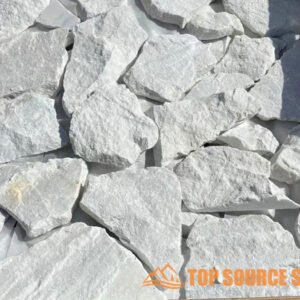 Random Loose Stone Cladding
Random Loose Stone Cladding -
 Grey Quartzite Random Loose Wall Claddding
Grey Quartzite Random Loose Wall Claddding -
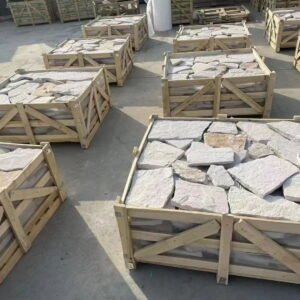 Exterior White Sandstone Random Loose Stone Wall Cladding
Exterior White Sandstone Random Loose Stone Wall Cladding -
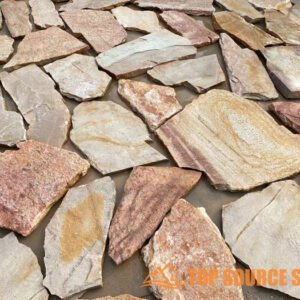 Natural Random Loose Stone Panels for Floor Application
Natural Random Loose Stone Panels for Floor Application -
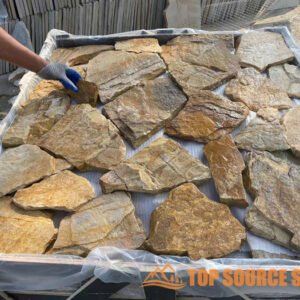 Natural Loose Stone Wall Cladding For Wall Decoration
Natural Loose Stone Wall Cladding For Wall Decoration -
 Natural Random Loose Stone Wall Cladding Panel for Indoor and Outdoor
Natural Random Loose Stone Wall Cladding Panel for Indoor and Outdoor
-
 Beige quartzite crazy pattern paving flagstone from China
Beige quartzite crazy pattern paving flagstone from China -
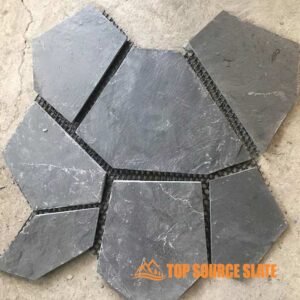 Black slate irregular random crazy paving flagstone
Black slate irregular random crazy paving flagstone -
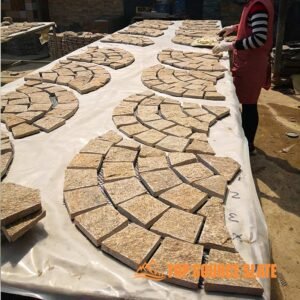 Natural stone crazy paving irregular slate flagstone for landscape
Natural stone crazy paving irregular slate flagstone for landscape -
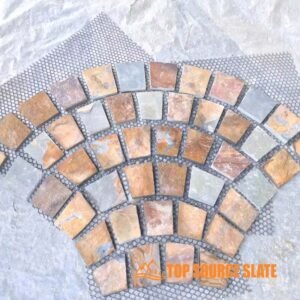 Chinese multicolor slate flagstone flooring mat mesh stone
Chinese multicolor slate flagstone flooring mat mesh stone -
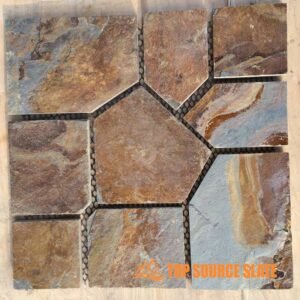 Slate crazy irregular flagstones mesh walkway paver
Slate crazy irregular flagstones mesh walkway paver -
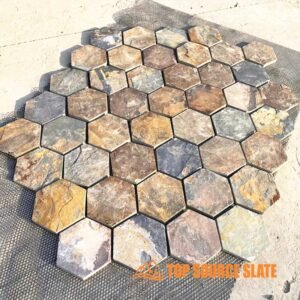 Irregular slate backed net flag paving stone
Irregular slate backed net flag paving stone -
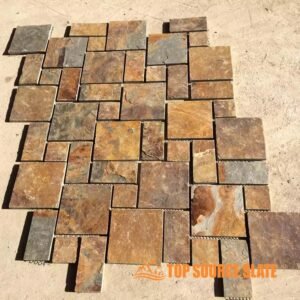 Natural rusty stone meshed flag walkway stone
Natural rusty stone meshed flag walkway stone -
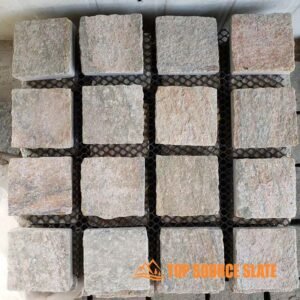 Square stone floor tiles driveway paving stone
Square stone floor tiles driveway paving stone
Planning and Design: Setting the Foundation for Success
Choosing the Right Location
Selecting the right spot for your flagstone patio is key. Consider sun exposure, proximity to your home, drainage, view, and how the patio fits with existing landscaping. A well-chosen location enhances usability and minimizes maintenance.
Designing Your Patio Layout
Decide on a pattern that matches your style. Popular choices include:
- Random/Irregular: Natural, organic look with stones of various shapes.
- Running Bond: A brick-like, staggered pattern for a structured appearance.
- Basket Weave: A classic, elegant design with perpendicular stone pairs.
- Circular/Fan: Ideal for round or curved patios, adding a dynamic focal point.
Ensure your design considers size, flow, and color coordination with your home and landscape.
Estimating Costs
Budgeting is essential. Costs can range from $15 to $30 per square foot, depending on factors like patio size, type of flagstone, and whether you hire professionals or DIY. Include costs for labor, additional features, and materials like gravel, sand, and sealant.
Gathering Tools and Materials
Prepare the following tools and materials before starting:
- Tools: Shovel, pickaxe, tape measure, marking paint, wheelbarrow, rubber mallet, level, tamping tool, masonry saw, and safety gear.
- Materials: Flagstone, gravel, sand, grout/joint material, and sealant.
Having everything on hand ensures a smooth installation process.
Preparing the Ground: Laying a Solid Foundation
A successful flagstone patio installation begins with proper ground preparation. The stability and longevity of your patio depend heavily on the foundation you create. This section will guide you through the essential steps of site preparation, laying the base, and ensuring proper drainage to prevent future issues.
Site Preparation: How to Clear and Level the Area
Before laying the first stone, you need to prepare the site by clearing and leveling the area. This step is crucial to ensure that your patio will be stable and even, preventing issues like shifting stones or water pooling.
Steps to Prepare the Site:
- Mark the Area: Use marking paint or stakes and string to outline the perimeter of your patio. This will serve as a guide for excavation and help you visualize the final size and shape of the patio.
- Remove Vegetation: Clear the area of grass, plants, and any other vegetation. A shovel or sod cutter can make this process easier. Be sure to remove the roots as well to prevent future growth under your patio.
- Excavate the Soil: Dig out the area to a depth of 6 to 8 inches. This depth allows room for the gravel base, sand layer, and flagstones. If your soil is particularly soft or prone to shifting, you may need to dig deeper and add a thicker base layer.
- Level the Ground: Use a long level or a flat board to check that the excavated area is even. If the ground is sloped, create a gentle grade to facilitate water runoff, directing it away from the house or other structures.
Establishing Proper Drainage: Preventing Water Accumulation
Proper drainage is essential to the longevity of your flagstone patio. Without it, water can accumulate under the stones, leading to shifting, cracking, and even damage to the foundation of your home.
Drainage Tips:
- Slope the Base: As you level the ground, ensure that there’s a slight slope (about 1/4 inch per foot) away from any buildings. This will help direct rainwater off the patio and prevent it from pooling.
- Install Drainage Pipes (if necessary): In areas with heavy rainfall or poor natural drainage, you might need to install drainage pipes or a French drain beneath the patio. This system will carry excess water away from the patio, protecting its integrity.
- Consider Permeable Joints: Using permeable joint materials, like sand or gravel, allows water to seep through the gaps between stones, reducing surface runoff and promoting natural drainage.
Laying the Base: The Importance of Gravel and Sand Layers
The base of your flagstone patio is its foundation, providing stability and preventing stones from shifting over time. A well-prepared base also ensures proper drainage, helping to maintain the integrity of your patio through various weather conditions.
Steps to Lay the Base:
- Spread Gravel: Begin by spreading a layer of crushed gravel (about 3 to 4 inches deep) across the entire excavated area. Gravel is essential for drainage and provides a solid base that resists shifting. Use a rake to distribute the gravel evenly.
- Compact the Gravel: Use a tamper or a plate compactor to compact the gravel layer firmly. Proper compaction is crucial to prevent the base from settling or shifting after the patio is installed. Repeat this process until the gravel is uniformly compacted.
- Add a Sand Layer: On top of the gravel, spread a 1 to 2-inch layer of sand. The sand provides a smooth, even surface for the flagstones to rest on and makes it easier to level the stones during installation. Use a straightedge or a board to level the sand layer.
Compacting the Base: Ensuring Stability for the Long Term
Compacting the base layers of gravel and sand is a critical step that directly impacts the durability of your flagstone patio. A well-compacted base will prevent the stones from shifting, settling, or becoming uneven over time.
Compaction Tips:
- Use the Right Tools: A manual tamper is suitable for small patios, but for larger areas, consider renting a plate compactor, which provides more force and efficiency.
- Compact in Layers: If your base is particularly deep (over 4 inches), compact the gravel in layers rather than all at once. This ensures that each layer is stable and well-compacted before adding more material.
- Check for Leveling: As you compact the base, periodically check the level with a straightedge or level tool. This step ensures that the surface remains even, which is crucial for the stability of the flagstones.
Once the base is fully compacted, you’ll have a solid, well-drained foundation ready for the next phase of the installation: laying the flagstones. Proper groundwork not only supports the weight of the stones but also helps your patio withstand the elements for years to come.
Installing the Flagstone: Step-by-Step Guide
With your site prepared and the base layers firmly in place, it’s time to start laying the flagstones. This phase of the project is where your patio truly begins to take shape. Careful placement and attention to detail during this stage will ensure that your flagstone patio is both beautiful and durable.
Dry Laying vs. Mortar Setting: Which Method is Best for You?
One of the first decisions you’ll need to make when installing a flagstone patio is whether to use the dry laying method or the mortar setting method. Each approach has its own advantages, and the choice will depend on your preferences, the climate in your area, and the specific look you’re aiming to achieve.
Dry Laying Method:
- Description: In this method, the flagstones are laid directly onto a bed of sand and gravel without the use of mortar. The stones are fit together as closely as possible, and the joints are filled with sand, gravel, or small pebbles.
- Advantages:
- Flexibility: Allows for natural movement of stones with ground settling, reducing the risk of cracking.
- Permeability: Water can seep through the joints, reducing runoff and helping with drainage.
- Ease of Repair: Individual stones can be easily lifted and replaced if needed.
- Disadvantages:
- Potential for Shifting: Stones may move slightly over time, especially in areas with freeze-thaw cycles.
- Weed Growth: The open joints can allow weeds to grow, requiring occasional maintenance.
Mortar Setting Method:
- Description: This method involves laying the flagstones on a bed of mortar, which is spread over a concrete slab or compacted base. The joints between the stones are also filled with mortar.
- Advantages:
- Stability: Provides a more solid and permanent installation, with less risk of stones shifting.
- Cleaner Look: Mortar joints create a smoother, more finished appearance.
- Resistance to Weeds: Mortar-filled joints prevent weed growth and reduce maintenance.
- Disadvantages:
- Labor-Intensive: Requires more skill and time to install correctly.
- Cost: Generally more expensive due to the need for additional materials and labor.
- Drainage Concerns: A mortar set patio may require proper drainage solutions to prevent water from pooling on the surface.
Creating a Cohesive Pattern: Tips for Arranging Your Flagstone Like a Pro
The way you arrange the flagstones on your patio will have a significant impact on the overall aesthetic. Whether you prefer a natural, irregular pattern or a more structured design, careful planning and placement are key.
Steps for Arranging Flagstone:
- Start with the Edges: Begin by placing the largest stones along the edges of the patio. This helps define the perimeter and creates a solid border for the interior stones.
- Work Inwards: Once the edges are set, work your way inward, fitting the stones together like a puzzle. Aim to minimize gaps between stones to create a tight, cohesive pattern.
- Vary the Shapes: Mix and match stones of different shapes and sizes to avoid uniformity. This adds visual interest and gives the patio a more natural look.
- Test Fit: Before setting each stone, test fit it in place to ensure it fits well with the surrounding stones. Adjust the position as needed to create a snug fit.
- Maintain Consistent Gaps: For a clean, professional finish, aim to keep the gaps between stones consistent. Typically, gaps should be around 1/4 to 1/2 inch, depending on the size and shape of the stones.
Design Tips:
- Use a Random Layout: For a natural, organic look, avoid creating straight lines or repeating patterns. Instead, use a random layout that mimics the irregularity of nature.
- Consider Color Variation: If your flagstones vary in color, distribute them evenly across the patio to create a balanced appearance.
- Incorporate Focal Points: Larger, uniquely shaped stones can be used as focal points to draw attention to specific areas of the patio.
Leveling the Flagstones: Achieving a Smooth and Even Surface
Achieving a level surface is crucial for your flagstone patio’s aesthetics and functionality. An uneven surface looks unprofessional and can create trip hazards and drainage issues.
Steps for Leveling Flagstone:
- Check the Base: Before laying each stone, ensure the sand layer beneath is level. Use a straightedge and level tool to check for any dips or high spots.
- Set the Stone: Place the flagstone on the sand base, making sure it sits firmly. If the stone wobbles, adjust the sand beneath until it lies flat.
- Tap into Place: Use a rubber mallet to gently tap the stone into the sand, ensuring it’s securely set. Avoid hitting too hard, as this could crack the stone.
- Check the Level: After setting each stone, use a level to check that it’s even with the surrounding stones. Adjust as necessary by adding or removing sand from underneath.
- Repeat the Process: Continue laying and leveling each stone, working systematically across the patio.
Pro Tip: Maintain a slight slope (about 1/4 inch per foot) across the patio to ensure proper water drainage. This prevents water from pooling on the surface and protects the patio from damage over time.
Filling the Gaps: Choosing the Right Joint Material for a Seamless Look
Once all the flagstones are in place, the next step is to fill the gaps between the stones. The material you choose for the joints will affect the patio’s appearance, functionality, and maintenance needs.
Common Joint Materials:
- Sand: A popular choice for dry-laid patios, and is easy to work with and allows water to drain through the joints. However, it may need to be replenished over time as it can wash away.
- Gravel or Pebbles: For a more rustic look, you can fill the joints with small gravel or pebbles. This option also promotes drainage and is relatively low maintenance.
- Mortar: Used in mortar-set patios, mortar creates a solid, permanent joint that prevents weed growth and provides a clean, finished look. However, it requires more skill to apply and may need to be sealed to prevent cracking.
Steps for Filling Joints:
- Spread the Material: Pour your chosen joint material over the patio, ensuring it fills all the gaps between the stones.
- Sweep into Gaps: Use a broom to sweep the material into the joints, filling them completely. Be sure to fill any deep or wide gaps to prevent movement or shifting.
- Compact the Material: For sand or gravel, use a tamper or simply walk over the patio to compact the material into the joints. This helps stabilize the stones and prevents the joint material from settling unevenly.
- Rinse the Surface: After filling the joints, gently rinse the patio with water to remove any excess material from the stone surfaces. For mortar joints, allow the mortar to set before rinsing.
Sealing the Surface: Protecting Your Patio from the Elements
Sealing your flagstone patio is an important step to protect it from the elements and extend its lifespan. Sealant helps prevent water penetration, reduce the growth of moss and algae, and enhance the natural color of the stone.
Types of Sealants:
- Penetrating Sealers: These sealers absorb into the stone, providing protection from within without altering the surface’s appearance. They are ideal for preserving the natural look of flagstone.
- Film-Forming Sealers: These create a protective layer on the surface of the stone, adding a slight sheen and enhancing the color. They offer more protection but can alter the stone’s appearance.
Steps for Sealing Flagstone:
- Clean the Surface: Before sealing, ensure the patio is clean and free of dirt, dust, and debris. Any contaminants on the surface will be sealed in and could affect the appearance.
- Apply the Sealant: Use a brush, roller, or sprayer to apply the sealant evenly across the flagstone surface. Be sure to follow the manufacturer’s instructions for application and drying times.
- Allow to Dry: Let the sealant dry completely before using the patio. This could take several hours to a full day, depending on the type of sealant and weather conditions.
- Reapply as Needed: Sealant typically needs to be reapplied every 2 to 3 years, depending on the level of exposure to the elements. Regular maintenance will help keep your patio looking great and extend its lifespan.
Sealing your flagstone patio not only enhances its beauty but also provides essential protection against the elements, ensuring your outdoor space remains stunning and functional for years to come.
Stacked Stone: A Complete Buyer’s Guide【update】
How to Install Stacked Stone or Ledge Stone
How to Build a Dry Stack Stone Wall
Finishing Touches: Bringing Your Flagstone Patio to Life
With the flagstones laid and the patio structure complete, it’s time to focus on the finishing touches that will turn your new outdoor space into a welcoming, functional, and beautiful area. These final steps will help ensure that your flagstone patio not only looks great but also meets your needs for years to come.
Edging and Borders: How to Keep Your Flagstone Secure
Edging plays a crucial role in maintaining the structure and stability of your flagstone patio. Properly installed edging prevents the stones from shifting and keeps the joint material in place, ensuring that your patio remains intact through weather changes and foot traffic.
Common Edging Options:
- Metal or Plastic Edging: These materials are flexible, making them ideal for curved or irregularly shaped patios. They are installed just below the surface, where they’re mostly invisible but effectively hold the stones and joint material in place.
- Stone or Brick Edging: You can use stone or brick as edging for a more integrated look. This option adds a decorative border that complements the flagstone, while also providing strong lateral support.
- Concrete Curbs: Concrete curbs offer a solid and permanent solution for maximum durability. They’re particularly useful in high-traffic areas or where the patio meets a lawn or garden bed.
Steps for Installing Edging:
- Dig a Trench: Dig a shallow trench around the perimeter of your patio, deep enough to accommodate the edging material. The trench should be level and follow the contour of the patio.
- Install the Edging: Place the edging material into the trench, ensuring it’s level and aligns with the top of the flagstones. If using flexible materials, secure them with stakes driven into the ground.
- Backfill and Compact: Backfill the trench with soil or gravel, and compact it to hold the edging firmly in place. This step helps prevent movement and keeps the edging stable over time.
- Finish the Edges: For a polished look, add a layer of soil, mulch, or decorative stone along the outside edge of the patio, blending it seamlessly into the surrounding landscape.
Landscaping Around the Patio: Complementary Planting Ideas
Landscaping around your flagstone patio can enhance its beauty and create a harmonious transition between the patio and the rest of your yard. The right combination of plants, shrubs, and other landscaping elements will not only soften the edges of the patio but also add color, texture, and privacy.
Planting Ideas for Patio Edges:
- Low-Growing Ground Covers: Plants like creeping thyme, sedum, or Irish moss are ideal for filling gaps between flagstones or along the edges. They’re low-maintenance, drought-tolerant, and add a lush, green border.
- Flowering Perennials: Perennials like lavender, salvia, or daylilies provide pops of color throughout the growing season. Plant them along the patio’s edge to create a vibrant and inviting space.
- Ornamental Grasses: Tall grasses like fountain grass or blue fescue add movement and texture, particularly when planted in clusters near the patio’s edges.
- Shrubs and Small Trees: For added privacy and structure, consider planting shrubs or small ornamental trees around the patio. Species like boxwood, hydrangea, or Japanese maple can create a natural screen that enhances the sense of enclosure.
Design Tips for Landscaping:
- Layering Plants: Create depth by layering plants of varying heights, with shorter plants in the front and taller ones behind. This approach adds visual interest and a sense of fullness.
- Seasonal Interest: Choose a mix of plants that bloom at different times of the year, ensuring that your patio is surrounded by color and life throughout the seasons.
- Lighting: Incorporate landscape lighting to highlight key features, such as plants, pathways, or the patio itself. Solar-powered or low-voltage lights are energy-efficient options that enhance both safety and ambiance.
Adding Outdoor Furniture and Décor: Creating a Cozy and Inviting Space
To fully enjoy your flagstone patio, furnish it with comfortable seating and decorative elements that reflect your personal style. Whether you envision your patio as a space for dining, lounging, or entertaining, the right furniture and décor will make it a functional and welcoming outdoor living area.
Furniture Ideas for Your Patio:
- Dining Sets: A sturdy table and chairs set the stage for outdoor meals and gatherings. Choose materials like metal, wood, or resin that can withstand the elements.
- Lounge Furniture: For a more relaxed vibe, consider outdoor sofas, armchairs, or a hammock. Cushions and pillows in weather-resistant fabrics add comfort and color.
- Fire Pits and Heaters: Extend the use of your patio into the cooler months with a fire pit, outdoor fireplace, or portable heater. These features provide warmth and create a cozy atmosphere.
Décor and Accessories:
- Outdoor Rugs: Define different areas of your patio with outdoor rugs. They add texture and warmth underfoot, while also anchoring furniture arrangements.
- Planters and Pots: Large planters filled with seasonal flowers or evergreen shrubs can add bursts of color and greenery to your patio. Group pots of varying sizes for a dynamic display.
- String Lights and Lanterns: Lighting is key to setting the mood on your patio. String lights, lanterns, or even LED candles create a soft, inviting glow in the evenings.
- Water Features: A small fountain or birdbath adds a soothing element to your patio. The sound of running water enhances relaxation and attracts wildlife.
Lighting Considerations: How to Illuminate Your Patio for Evening Use
Proper lighting extends the usability of your flagstone patio into the evening hours, allowing you to enjoy the space long after the sun has set. Thoughtful lighting not only enhances safety but also creates ambiance and highlights the beauty of your outdoor space.
Types of Patio Lighting:
- Pathway Lights: These low-level lights are installed along walkways or around the perimeter of the patio to illuminate the ground and prevent tripping hazards.
- Overhead String Lights: String lights draped overhead to create a festive, starry effect. They’re perfect for casual gatherings or romantic evenings.
- Spotlights: Use spotlights to highlight specific features, such as a seating area, a water feature, or a particularly beautiful plant. Adjustable spotlights can be aimed to create the desired effect.
- Lanterns and Candles: Portable lanterns and LED candles add a warm, flickering light to your patio. They’re ideal for creating a cozy, intimate atmosphere.
Lighting Tips:
- Layer Your Lighting: Combine different types of lights (ambient, task, and accent) to create a balanced and flexible lighting scheme.
- Use Timers and Sensors: Consider installing timers or motion sensors to automate your lighting. This not only saves energy but also ensures your patio is well-lit when you need it.
- Choose Weather-Resistant Fixtures: Outdoor lighting fixtures should be durable and designed to withstand the elements. Look for fixtures with high IP ratings (Ingress Protection) to ensure they’re suitable for outdoor use.
With the right finishing touches, your flagstone patio will not only be a beautiful addition to your home but also a functional and inviting outdoor living space that you can enjoy throughout the year.
Slate Flagstone: A Complete Buyer’s Guide【update】
How to Lay Crazy Paving: A Step-by-Step Guide
Installation Tips for Random Loose Stone Cladding
Maintenance and Care: Keeping Your Flagstone Patio in Top Condition
After investing time and effort into creating your beautiful flagstone patio, it’s essential to maintain it properly to ensure its longevity and preserve its appearance. Regular maintenance will help prevent issues like weed growth, staining, and shifting stones, keeping your patio looking pristine and inviting for years to come.
Routine Cleaning: How to Remove Dirt and Stains
Regular cleaning is the first step in maintaining your flagstone patio. Over time, dirt, debris, and organic matter can accumulate on the surface, leading to discoloration and potential damage if not addressed.
Steps for Routine Cleaning:
- Sweeping: Regularly sweep the patio with a stiff-bristled broom to remove loose dirt, leaves, and other debris. This simple task prevents buildup and reduces the risk of stains.
- Rinsing: Use a garden hose to rinse off the patio surface. This helps remove dust and small particles that can cause abrasion. If you have access to a pressure washer, use it on a low setting to avoid damaging the stone.
- Spot Cleaning Stains: For stains caused by food, drink, or organic matter, create a gentle cleaning solution by mixing warm water with a few drops of dish soap. Apply the solution to the stained area, scrub gently with a soft brush, and rinse thoroughly. Avoid using harsh chemicals or acidic cleaners, as they can damage the stone.
Dealing with Tough Stains:
- Grease and Oil Stains: Sprinkle baking soda or cornstarch on the stain to absorb the oil. Let it sit for a few hours before brushing it off and cleaning it with a mild soap solution.
- Moss and Algae: Mix equal parts water and white vinegar, apply to the affected area, and scrub with a brush. Rinse well afterward.
- Rust Stains: For rust, use a specialized stone cleaner designed to remove rust stains without damaging the stone. Follow the manufacturer’s instructions carefully.
Preventing Weeds and Moss: Tips for Maintaining a Pristine Look
Weeds and moss can detract from the appearance of your flagstone patio and may even cause damage over time. Regularly addressing these issues will help maintain the patio’s clean, attractive look.
Weed Prevention Tips:
- Fill Gaps Properly: Make sure the joints between stones are filled with an appropriate material like polymeric sand, which hardens when wet and resists weed growth.
- Apply a Pre-Emergent Herbicide: Before weeds start growing, apply a pre-emergent herbicide to the joints between the stones. This prevents weed seeds from germinating.
- Hand Pulling: If weeds do appear, remove them by hand before they have a chance to establish deep roots. Be careful to pull out the entire root to prevent regrowth.
Controlling Moss Growth:
- Increase Sunlight Exposure: Moss thrives in damp, shaded areas. If possible, trim nearby trees or bushes to increase sunlight exposure on the patio.
- Improve Drainage: Ensure that water drains properly from the patio surface, as standing water encourages moss growth. Reapply joint material or adjust the patio’s slope if necessary.
- Use Moss Killer: For persistent moss, apply a moss killer specifically designed for stone surfaces. Follow the product instructions carefully, and rinse the area thoroughly after treatment.
Resealing the Flagstone: When and How to Apply Sealant
Sealing your flagstone patio helps protect it from the elements, reduces staining, and enhances the stone’s natural color. Over time, the sealant may wear down, requiring reapplication to maintain the patio’s protection and appearance.
When to Reseal:
- Frequency: Typically, flagstone patios should be resealed every 2 to 3 years, depending on the level of exposure to sunlight, rain, and foot traffic. However, if you notice the stone becoming more absorbent (e.g., water no longer beads up on the surface), it’s a sign that resealing is needed.
- After Deep Cleaning: If you’ve performed a deep cleaning that involved scrubbing or pressure washing, it’s a good idea to reseal the patio to restore its protective layer.
How to Reseal:
- Clean the Patio: Before applying new sealant, ensure the patio is clean and free of dirt, stains, and debris. Allow the surface to dry completely before proceeding.
- Choose the Right Sealant: Select a sealant that is appropriate for the type of flagstone you have and the climate in your area. Penetrating sealers are ideal for maintaining a natural look while film-forming sealers provide a slight sheen and enhanced color.
- Apply the Sealant: Use a brush, roller, or sprayer to apply the sealant evenly across the patio surface. Work in small sections to ensure complete coverage and avoid pooling.
- Allow to Dry: Let the sealant dry according to the manufacturer’s instructions. This could take several hours to a full day, depending on the product and weather conditions.
- Avoid Traffic: Keep foot traffic off the patio until the sealant is fully cured. This helps ensure a durable, long-lasting finish.
Addressing Common Issues: Troubleshooting Cracks and Settling
Even with the best preparation and installation, your flagstone patio may eventually experience some issues like cracks, settling stones, or uneven surfaces. Addressing these problems promptly will help maintain the patio’s integrity and appearance.
Common Issues and Solutions:
- Cracks in Stones: Small cracks can be filled with epoxy or a stone filler designed for outdoor use. For larger cracks, consider replacing the affected stone entirely to prevent further damage.
- Settling Stones: If a stone becomes uneven or sinks over time, carefully lift it out and add more sand or gravel underneath to restore the level. Compact the base material before resetting the stone.
- Loose Stones: If a stone feels loose or wobbles underfoot, remove it and reapply joint material or mortar beneath it. Compact the material well before resetting the stone to ensure stability.
Proactive Maintenance Tips:
- Inspect Regularly: Periodically check the patio for signs of wear, shifting, or damage. Early detection allows for easier and less costly repairs.
- Clean Joints: Keep the joints between stones clean and free of debris to prevent blockages that could lead to water retention or weed growth.
- Replenish Joint Material: Over time, joint material may wash away or settle. Reapply sand, gravel, or mortar as needed to keep the joints filled and stable.
Conclusion: Enjoying Your New Flagstone Patio
After investing time, effort, and resources into installing your flagstone patio, it’s time to enjoy the fruits of your labor. A well-constructed flagstone patio not only enhances the aesthetic appeal of your outdoor space but also provides a functional area for relaxation, entertainment, and family gatherings. With proper care and maintenance, your patio will remain a beautiful and durable feature of your home for many years.
Ideas for Outdoor Living: Making the Most of Your New Space
Now that your flagstone patio is complete, it’s time to think about how you’ll use this new outdoor space. Whether you envision it as a tranquil retreat or a lively entertainment area, there are countless ways to make the most of your patio.
Outdoor Living Ideas:
- Alfresco Dining: Set up an outdoor dining area with a sturdy table and comfortable chairs. Add a grill or outdoor kitchen for the ultimate alfresco dining experience.
- Lounge and Relaxation Area: Create a cozy lounge space with cushioned sofas, armchairs, and a coffee table. Consider adding an outdoor rug for extra comfort and style.
- Entertaining Space: Set up a fire pit or outdoor fireplace as a focal point for gatherings. Surround it with seating and add string lights or lanterns for a warm, inviting ambiance.
- Garden Oasis: Integrate your patio into the surrounding landscape by adding planters, garden beds, or a water feature. This can create a seamless transition between the patio and the natural elements of your yard.
- Outdoor Office: For those who enjoy working from home, consider setting up a small table and chair for an outdoor office space. The fresh air and natural surroundings can boost productivity and creativity.
Long-Term Benefits: Why Your Flagstone Patio Will Stand the Test of Time
Choosing flagstone for your patio is a long-term investment in your home’s beauty and functionality. Unlike many other materials, flagstone is incredibly durable and able to withstand the elements while maintaining its natural charm. With proper installation and maintenance, your flagstone patio will continue to provide a sturdy, attractive surface for decades.
Top Source Slate excels in all these areas, making us the best accomplice in your stone cladding wishes, whether you’re working on outside house stone cladding or an indoor characteristic wall. Contact us today to learn more about how we will help your next assignment.

